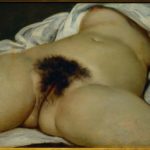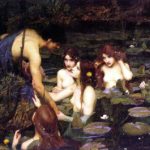Performance artist Deborah De Robertis was being silenced during her lecture in the Brussels museum Bozar on censorship and the image of women in art. De Robertis talked about and showed her performances: posing naked in front of famous artworks such as L’Origine du Monde, painted by Gustave Courbet in 1866. Besides this, major world-known museums are planning to change text panels and give more context, explanation or even warnings for exhibited works of art that make the chaste visitor a bit nervous. Recently, John William Waterhouse’s painting with seven topless water nymphs is temporarily removed from the Manchester Art Gallery.
Left: L’Origine du Monde, Gustave Courbet, 1866, oil on canvas. Source: Wikipedia. Right: Hylas and the Nymphs, John William Waterhouse, 1896, oil on canvas. Source: Wikipedia.
Chastity and chasing titties
Wait a minute. Is this the state of affairs of sixty years ago? No. They are part of the news of this month. March 2018. The Dutch newspaper NRC proclaims that a new wave of chastity seems to wash up in the art world. When, with the arrival of Christianity, heroic nudity (as we know it from the Ancient Greek and Romans) disappeared, fig leaves had to cover the genitals. The same seems to apply for contemporary nudity. The well-known social media channels like Facebook and Instagram are also guilty of this. For example, Facebook ‘’accidentally’’ deleted an image of the 30.000-year-old Venus of Willendorf and also L’Origine du Monde has been removed several times. The growing social media platform Instagram removes rigorously images of visible, free nipples, from which an ongoing discussion about the equality between men and women has resulted. Instagram accepts bare male nipples, but those of women should be covered, according to Instagram.

Venus of Willendorf, created between 28,000 and 25,000 BCE. Oolitic Limestone. Naturhistorisches Museum Vienna, Austria. Source: Wikipedia.
Whose freedom?
Are we going too far? Are we placing a label of immorality on a work of art too quickly? Critic Jonathan Jones commented recently in the British newspaper The Guardian that “nowadays, it is cool to be hurt by a hundred-year-old work of art” and that “with the great liberties of modernity, whether you like it or not, also comes the freedom of sexual expression.” But where do we have to draw the line? What is the boundary between the freedom of sexual expression and art versus the ‘pornification’ of society where the equality between men and women is debatable? A complex example of this question is the fact that many paintings of female nudity are made by male artists who did not necessarily deal with their models in a female-friendly way. Art history is covered with stories wherein men misbehaved against women. Thé big player-painter is of course Picasso, but also the Dutch artist George Hendrik Breitner couldn’t keep his hands off the very young model Geesje.
It’s not the art, it’s the society
Director of the Rijksmuseum, Taco Dibbits, stated that “it is not the art that is changing, it is our society”. By removing paintings, he proclaims, you also remove the cultural historic discussion, which would be a shame. Larissa Bonfante explains with her article Nudity as a Costume in Classical Art that we can distinguish different forms of nudity. Religious, ritual or divine nudity are all categories of nudity. A naked goddess Venus is a different sort of nudity than an undressed sacred prostitute who serves at a temple while performing rituals. Bonfante explains that nudity is related to meanings and certain circumstances: “Just as clothing could serve different purposes, so nakedness and nudity could have different meanings.” For example, in the Old Testament nudity was always seen as being in a state of poverty and shame, quite similar to the situation nowadays. In addition to this, painting or carving a naked body was also a sort of ‘business card’, a historic LinkedIn page for the artist to show what he was capable of. Creating the human body with all its typical details was and still is one of the most difficult tasks for artists.
Generalizing genitals
The problem with images of nudity nowadays is that most people put them under one umbrella. Pornographic photo’s of lingerie models are being compared to paintings with nude models hundreds of years ago. Slowly, we become alienated from the context and the meaning of nudity. As pointed out by Bonfante, nudity has a range of meanings. Thereby, the creation process and the way in which models, then and now, were treated are linked to the right of existence and publicity of the artwork. This doesn’t make sense and it’s not fair. Ofcourse, it is a usefull and educational addition to explain how an artists (ab)used their models to raise awareness and reflection for the observers, but in order to do this, we need those artworks to be open and visible for the public. To change the way people treat women nowadays, but even more important, to teach the public that nudity is related to context and can still be divine, relgious, liberating and connected to quality. If we’re able to judge with this open-minded vision, we not only do justice to the modern ideal of artistic freedom, but in fact, we go back in time, respecting the artwork on the basis of the time in which it was made.

